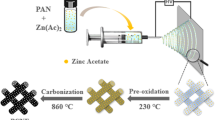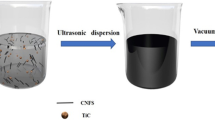Abstract
Compared to conventional lithium batteries, lithium-sulfur (Li–S) batteries are not only low-cost and environmentally friendly but also have a high theoretical energy density. However, the insulating nature of sulfur materials and the poor cycle stability of Li–S batteries inhibit their commercialization. Herein, porous carbon nanofibers (PCNFs) were fabricated by a facile electrospinning method and used as a cathode hosting sulfur for Li–S batteries. The porous structure effectively restrained soluble polysulfides from migrating due to shuttle effect of lithium-sulfur batteries. With the PCNFs as the sulfur host, the PCNFs/S cathode exhibited excellent cycling stability. An initial specific capacity of 835 mAh g−1 at 0.1C and a reversible capacity of 98.6% after 100 cycles were achieved. This outstanding performance can be ascribed to the rational design of the electrode structure, which can increase the interfacial contact and provide a large number of electrochemically active sites for polysulfide storage.








Similar content being viewed by others
References
Dong Y, Guan S, Zhou X et al (2021) Co-intercalation of CTAB favors the preparation of Ti3C2Tx/PANI composite with improved electrochemical performance[J]. Ionics 27(6):2501–2508
Peng L, Wei Z, Wan C et al (2020) A fundamental look at electrocatalytic sulfur reduction reaction[J]. Nat Catal 3(9):762–770
Qie L, Manthiram A (2015) A facile layer-by-layer approach for high-areal-capacity sulfur cathodes[J]. Adv Mater 27(10):1694–1700
Su W (2018) Porous honeycomb-like carbon prepared by a facile sugar-blowing method for high-performance lithium-sulfur batteries[J]. Int J Electrochem Sci 13(6):6005–6014
Zhang Y, Li M, Zhong S et al (2020) MoS2 wrapped MOFs-derived N-doped carbon nanorods as an effective sulfur host for high-performance lithium-sulfur batteries[J]. Ceram Int 46(7):9614–9621
Qu Y, Zhang Z, Zhang X et al (2015) Highly ordered nitrogen-rich mesoporous carbon derived from biomass waste for high-performance lithium–sulfur batteries[J]. Carbon 84(1):399–408
Peng H, Wang X, Zhao Y et al (2017) Enhanced electrochemical performance of sulfur/polyacrylonitrile composite by carbon coating for lithium/sulfur batteries[J]. J Nanopart Res 19(10):1–8
Pan H, Cheng Z, Chen J et al (2020) High sulfur content and volumetric capacity promised by a compact freestanding cathode for high-performance lithium–sulfur batteries[J]. Energy Storage Mater 27:435–442
Wang J, Yang Y, Kang F (2015) Porous carbon nanofiber paper as an effective interlayer for high-performance lithium-sulfur batteries[J]. Electrochim Acta 168:271–276
Kuzmenko V, Naboka O, Staaf H et al (2015) Capacitive effects of nitrogen doping on cellulose-derived carbon nanofibers[J]. Mater Chem Phys 160:59–65
Cheng J, Song H, Pan Y et al (2018) 3D copper foam/bamboo charcoal composites as high sulfur loading host for lithium-sulfur batteries[J]. Ionics 24(12):4093–4099
Gu X, Wang Y, Lai C et al (2014) Microporous bamboo biochar for lithium-sulfur batteries[J]. Nano Res 8(1):129–139
Kalybekkyzy S, Mentbayeva A, Yerkinbekova Y et al (2020) Electrospun 3D structured carbon current collector for Li/S batteries[J]. Nanomaterials 10(4):745–758
Tesio AY, Gomez-Camer JL, Morales J et al (2020) Simple and sustainable preparation of nonactivated porous carbon from brewing waste for high-performance lithium-sulfur batteries[J]. Chemsuschem 13(13):3439–3446
Liu H, Wang Z, Wu Z et al (2020) Direct tuning of meso-/micro-porous structure of carbon nanofibers confining Sb nanocrystals for advanced sodium and potassium storage[J]. J Alloy Compd 833:155127
Yang D, Ni W, Cheng J et al (2017) Flexible three-dimensional electrodes of hollow carbon bead strings as graded sulfur reservoirs and the synergistic mechanism for lithium–sulfur batteries[J]. Appl Surf Sci 413:209–218
Strubel P, Thieme S, Biemelt T et al (2015) ZnO hard templating for synthesis of hierarchical porous carbons with tailored porosity and high performance in lithium-sulfur battery[J]. Adv Func Mater 25(2):287–297
Kalybekkyzy S, Mentbayeva A, Kahraman MV et al (2019) Flexible S/DPAN/KB nanofiber composite as binder-free cathodes for Li-S batteries[J]. J Electrochem Soc 166(3):A5396–A5402
Wang J, Yang G, Chen J et al (2019) Flexible and high-loading lithium–sulfur batteries enabled by integrated three-in-one fibrous membranes[J]. Adv Energy Mater 9(38):1902001
Liu Y, Haridas AK, Lee Y et al (2019) Freestanding porous sulfurized polyacrylonitrile fiber as a cathode material for advanced lithium sulfur batteries[J]. Appl Surf Sci 472:135–142
Zhang YZ, Zhang Z, Liu S et al (2018) Free-standing porous carbon nanofiber/carbon nanotube film as sulfur immobilizer with high areal capacity for lithium-sulfur battery[J]. ACS Appl Mater Interfaces 10(10):8749–8757
Zhang L, Aboagye A, Kelkar A et al (2014) A review: carbon nanofibers from electrospun polyacrylonitrile and their applications[J]. J Mater Sci 49(2):463–480
Li Y, Zhu J, Zhu P et al (2018) Glass fiber separator coated by porous carbon nanofiber derived from immiscible PAN/PMMA for high-performance lithium-sulfur batteries[J]. J Membr Sci 552:31–42
Wang YH, Bayatpour S, Qian X et al (2020) Activated carbon fibers via reductive carbonization of cellulosic biomass for adsorption of nonpolar volatile organic compounds[J]. Colloids Surf A Physicochem Eng Asp 612:125908
Zhao X, Kim M, Liu Y et al (2018) Root-like porous carbon nanofibers with high sulfur loading enabling superior areal capacity of lithium sulfur batteries[J]. Carbon 128:138–146
Wang D, Cao Q, Jing B et al (2020) A freestanding metallic tin-modified and nitrogen-doped carbon skeleton as interlayer for lithium-sulfur battery[J]. Chem Eng J 399:125723
Kim M, Lim J, Bak J et al (2019) Fe and N codoped mesoporous carbon nanofiber as a nonprecious metal catalyst for oxygen reduction reaction and a durable support for Pt nanoparticles[J]. ACS Sustain Chem Eng 7(20):17544–17552
Zeng L, Jiang Y, Xu J et al (2015) Flexible copper-stabilized sulfur-carbon nanofibers with excellent electrochemical performance for Li-S batteries[J]. Nanoscale 7(25):10940–10949
Mentbayeva A, Belgibayeva A, Umirov N et al (2016) High performance freestanding composite cathode for lithium-sulfur batteries[J]. Electrochim Acta 217:242–248
Wang Q, Fang L, Chen J et al (2015) Genome-wide mining, characterization, and development of microsatellite markers in gossypium species[J]. Sci Rep 5(1):1–10
Yang J, Wang S, Ma Z et al (2015) Novel nitrogen-doped hierarchically porous coralloid carbon materials as host matrixes for lithium–sulfur batteries[J]. Electrochim Acta 159:8–15
Zeng JH, Wang YF, Gou SQ et al (2017) Sulfur in hyper-cross-linked porous polymer as cathode in Lithium-Sulfur batteries with enhanced electrochemical properties[J]. ACS Appl Mater Interfaces 9(40):34783–34792
Cheng Q, Xu W, Qin S et al (2019) Full dissolution of the whole lithium sulfide family (Li2S8 to Li2S) in a safe eutectic solvent for rechargeable Lithium-Sulfur batteries[J]. Angew Chem 131(17):5613–5617
Zhang Y, Zhao Y, Bakenov Z et al (2013) Effect of graphene on sulfur/polyacrylonitrile nanocomposite cathode in high performance lithium/sulfur batteries[J]. J Electrochem Soc 160(8):A1194–A1198
Zhang S (2014) Understanding of sulfurized polyacrylonitrile for superior performance lithium/sulfur battery[J]. Energies 7(7):4588–4600
Zhu J, Ge Y, Kim D et al (2016) A novel separator coated by carbon for achieving exceptional high performance lithium-sulfur batteries[J]. Nano Energy 20:176–184
He MX, Li X, Li WH et al (2021) Immobilization and kinetic promotion of polysulfides by molybdenum carbide in lithium-sulfur batteries[J]. Chem Eng J 411:128563
Waluś S, Barchasz C, Bouchet R et al (2020) Electrochemical impedance spectroscopy study of lithium–sulfur batteries: useful technique to reveal the Li/S electrochemical mechanism[J]. Electrochim Acta 359:136944
Fang R, Zhao S, Pei S et al (2016) Toward more reliable lithium-sulfur batteries: an all-graphene cathode structure[J]. ACS Nano 10(9):8676–8682
Funding
This work was supported by the Zhejiang Provincial Natural Science Foundation of China (grants nos. LY21F040008, LY21E020011), the Applied Basic Research Project of China National Textile and Apparel Council (grant no. J201801), and the Fundamental Research Funds of Zhejiang Sci-Tech University.
Author information
Authors and Affiliations
Corresponding authors
Additional information
Publisher's Note
Springer Nature remains neutral with regard to jurisdictional claims in published maps and institutional affiliations.
Rights and permissions
About this article
Cite this article
Jin, Z., Ma, X., Qiu, L. et al. Porous carbon nanofibers prepared by low-cost and environmentally friendly ammonium chloride for high-performance Li–S batteries. Ionics 28, 1157–1166 (2022). https://doi.org/10.1007/s11581-021-04350-0
Received:
Revised:
Accepted:
Published:
Issue Date:
DOI: https://doi.org/10.1007/s11581-021-04350-0




